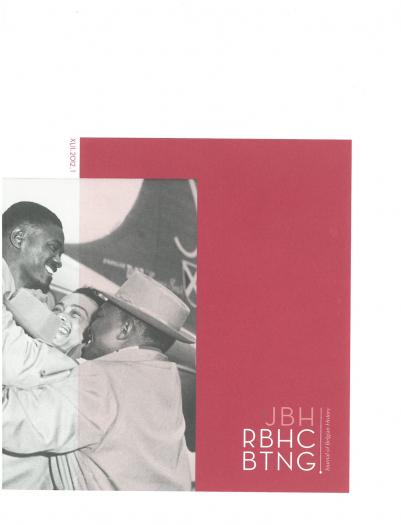The Cold War in the 'new' JBH

The current Journal of Belgian History (Belgisch Tijdschrift voor Nieuwste Geschiedenis/Revue belge d’Histoire contemporaine - JBH/BTNG/RBHC) originated in 2012 from the merger between its eponymous predecessor and the Bijdragen tot de Eigentijds Geschiedenis/Cahiers d'Histoire du Temps présent (BEG/CHTP) which succeeded the Bijdragen tot de Geschiedenis van de Tweede Wereldoorlog/Cahiers d’histoire de la deuxième guerre mondiale in 1997. This page contains a review of articles related to Cold War history published in the "new" JBH. A similar review of such publications in the 'old' JBH can be found here. If you are looking for Cold War-related research in the BEG/CHTP (and its predecessor) please find it here.
In its first year of publication, the 'new' JBH immediately gave a rather prominent place to Belgian Cold War research. In each issue, at least one article included this conflict as a factor in the analysis.
For example, Anne-Sophie Gijs emphasized in her study of, among other things, the ideological beliefs of the first Congolese Prime Minister Patrice Lumumba that he was mainly capitalizing on the bipolarity of the Cold War and always kept his real ideological affinities vague, so as not to neglect possible support from both camps (2012/1).
Frank Gerits questioned American public diplomacy through the activities of the United States Information Service in 1950s Brussels. He found that it focused its propaganda activities favoring Belgian participation in the Korean War and the European Defense Community not so much on the population but directly on the government. Only afterwards was the broader society targeted, although this did not happen easily (2012/4).
Then again, in the 2012 theme issue, on the memory of World War II, in particular, guest editors Bruno Benvindo and Evert Peeters in their individual articles on Breendonk camp memories and patriotic war commemorations attributed a certain weight to the East-West conflict in polarizing rival war memories (2012/2-3).
One year after Gijs, Vincent Genin also placed his reflections on French foreign policy toward the Congo issue at the intersection of Cold War research and decolonization literature (2013/1). Kim Christiaens brought a Cold War dimension to the historiography of European social movements a little later with his analysis of Belgian mobilization against political persecution in the Brazilian dictatorship of the 1970s (2013/4).
In the following years, JBH readers were presented with several more articles highlighting the diversity of actors and practices on the international scene during the Cold War. Now this may be true to a slightly lesser extent for Vincent Delcorps' study of how the Belgian diplomatic apparatus dealt with the challenges of multilateralism (2014/4), than for Rafael Pedemonte Lavis' examination of Belgian cultural relations with Hungary in the aftermath of the 1956 Budapest uprising (2015/1).
In 2019, we find another JBH article on the interaction between decolonization and the Cold War, although its author, Colin Hendrickx, minimized the impact of the East-West conflict on Belgian-Zairean relations during the Mobutu era (2019/1).
A year later, Elie Teicher more or less tied in with Christiaens' research by focusing on the political engagement of Belgian writer Conrad Detrez, who spent a long time in Brazil. In his article, Teicher made no explicit reference to the Cold War but rather focused on his protagonist's shifting positions between a Catholic anti-communism at the beginning of the 1960s to his participation in the activities of a Brazilian communist splinter movement in the late 1960s and again distancing himself from this ideology toward the end of his life (2020/1).
Still in 2020, Thomas Briamont studied bilateral relations during the early Cold War in order to assess the weight of different determinants of foreign policymaking. Following Christoph Brüll's work on Belgian-German relations, he advocated for a broader framework than the strategic-military security paradigm. In particular, he emphasized the mental construction of military threat and the ways in which a number of actors weighing in on policy gave meaning to it (2020/2).
The following year, Bram De Maeyer contributed to the JBH a piece from his doctoral research on postwar Belgian embassy architecture. The article he co-authored with his supervisors Fredie Floré and Anne-Françoise Morel on the Belgian chancellery in Washington provides a nice illustration of how diplomats and architects worked together in the early Cold War era in order to strengthen transatlantic ties (2021/3).
Ten years after Benvindo and Peeters' thematic issue on the memory of World War II, Babette Weyns also pointed out that after a brief period of liberation and reconstruction, the Cold War soon sensitively reinforced polarization between communists and anti-communists among former resistance members (temporary link - 2022/1-2).
2022 was also the year of the seventy-fifth anniversary of the beginning of the Cold War. In response, Michael Auwers published a review article on how Belgian historians have studied the conflict in recent decades (2022/3). A summary of that article can be found here.